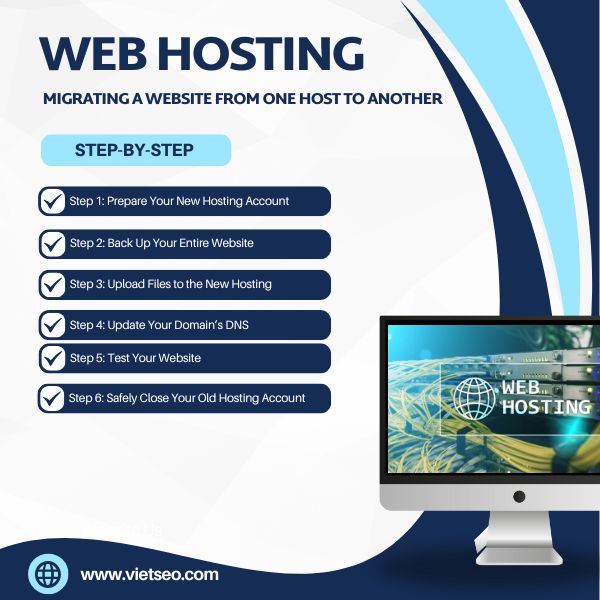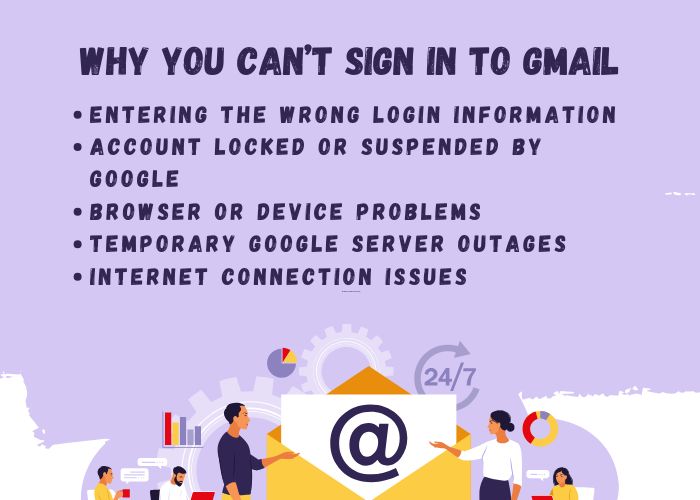Steps to Migrate a Website from One Hosting to Another – Complete Guide
In this guide, we’ll walk you through the step-by-step process of moving your website from your current hosting provider to a new one. Our goal is to help you migrate safely, quickly, and without disrupting your site’s operation. Whether you’re running WordPress or another type of platform, the essential steps remain quite similar.
Why Consider Moving Your Website to a New Host?
There are many situations where switching to a different hosting provider becomes the best choice. Some of the most common reasons include:
- Slow website performance – If your pages take too long to load, visitors will leave, and search engines may rank you lower. Often, this happens because your existing hosting package can no longer handle the growing traffic or resource demand of your site.
- Limited server resources – As your business grows, you may need more disk space, bandwidth, or RAM. A hosting plan that was once sufficient may now be holding you back.
- Unreliable customer support – When issues arise, fast and knowledgeable technical support is crucial. Poor support experiences can waste your time and even cause serious downtime.
- High hosting costs – Many businesses eventually realize they are paying too much for their current plan, especially if the performance does not match the price.
- Downtime or server errors – If your site frequently goes offline, it not only frustrates visitors but also harms your reputation and SEO rankings.
Migrating to a better hosting provider can solve all of these challenges—provided the migration is done properly. At VietSEO, we specialize in helping businesses make this transition smooth and worry-free, with tailored solutions for different platforms and business needs.
Step-by-Step Guide to Migrating a Website from One Host to Another
Switching your website to a new hosting provider might sound intimidating, but with the right approach, it can be a straightforward and secure process. The key is to move carefully—step by step—so you don’t risk downtime, broken features, or lost data.
At VietSEO, we’ve helped countless businesses transition to new hosting smoothly. Below, we’ll walk you through the exact steps you should follow to ensure your website stays safe, fast, and fully functional throughout the migration.
Step 1: Prepare Your New Hosting Account
The first step is to set up your new hosting environment. Choose a plan that fits your website’s needs now, while leaving room for future growth. Look for:
- Server location close to your main audience (for faster load times)
- Adequate resources such as storage, bandwidth, and RAM
- Ease of use, with a control panel like cPanel or Plesk (if you’re already familiar)
- Good technical support that responds quickly and effectively
- Free website migration service, especially if you prefer not to handle the technical side yourself
Once registered, make sure your account is active and ready to receive files before you move anything over.
Step 2: Back Up Your Entire Website
Before making changes, back up everything from your current host. This is your safety net in case something goes wrong.
You’ll need to save two main components:
- Website files – All content, themes, plugins, and scripts (found in the
public_htmldirectory or root folder). - Database – Usually MySQL, which stores your site’s content, settings, and user data.
How to back up:
- Use File Manager (in your hosting panel) or an FTP client like FileZilla to download all your website files.
- Access phpMyAdmin and export your database as a
.sqlfile.
Pro tip: Name your backups clearly (e.g., mywebsite_files_backup_2025.zip) and store them somewhere safe, such as Google Drive or Dropbox.
Step 3: Upload Files to the New Hosting
With backups ready, you can now move your site to the new server.
- Website files: Upload everything to the
public_htmlfolder of your new hosting account (via FTP or File Manager). - Database:
- Create a new database in your new host’s control panel.
- Open phpMyAdmin → Import → upload your
.sqlfile.
Next, update your website’s configuration file so it connects to the new database.
For WordPress sites, open wp-config.php and replace the database details:
define('DB_NAME', 'new_database_name');
define('DB_USER', 'new_database_user');
define('DB_PASSWORD', 'new_password');
define('DB_HOST', 'localhost');
Step 4: Update Your Domain’s DNS
Now it’s time to point your domain name to your new hosting provider.
- Log in to your domain registrar (e.g., GoDaddy, Namecheap, Z.com).
- Find the DNS/Nameserver management section.
- Replace the old nameservers with your new host’s nameservers (e.g.,
ns1.newhost.com,ns2.newhost.com).
DNS updates can take anywhere from 1 to 48 hours to fully propagate worldwide.
Step 5: Test Your Website
Once the DNS update is live, test your website thoroughly:
- Does the homepage load correctly?
- Do internal links, images, and menus work as expected?
- Are important features (logins, checkout, search, contact forms) functioning?
- Are there any 404 or 500 errors?
To test before DNS propagation finishes, you can edit your computer’s hosts file to preview your site directly on the new server.
Step 6: Safely Close Your Old Hosting Account
Only cancel your old hosting plan once you’re 100% sure the new one is working perfectly.
Before closing:
- Confirm that all files, databases, and email accounts have been migrated.
- Re-check cron jobs, scheduled tasks, or plugins that may still be pointing to the old server.
- Keep your old host active for a few extra days (if possible) as a backup safety net.
Following these steps carefully will ensure a smooth migration with minimal risk. And if you prefer expert help, Viet SEO can handle the entire process for you—so you can focus on your business while we make the move seamless.
Viet SEO’s Important Notes for a Smooth Hosting Migration
Migrating a website isn’t just about copying files from one server to another. It requires careful planning and attention to detail to make sure your site stays secure, functional, and accessible throughout the process. Skipping steps or rushing can lead to downtime, broken features, or even lost data.
At VietSEO, we’ve seen the common mistakes businesses make during migrations, so we’ve put together a few practical tips to help you avoid problems:
- Always create a backup – Even if you’ve successfully migrated websites in the past, don’t skip this step. A fresh backup ensures you can restore your site immediately if something goes wrong.
- Choose the right time to migrate – Schedule the move during off-peak hours, such as late at night or weekends, to minimize disruption for visitors and customers.
- Notify your users – If you expect downtime or maintenance, it’s good practice to let your users know in advance. A simple notice or banner can help maintain trust.
- Reinstall SSL certificates – Some hosting providers don’t transfer SSL/TLS automatically. After migration, make sure your site is still served over HTTPS by reinstalling or reissuing your SSL certificate.
By keeping these points in mind, you’ll reduce risks and ensure your hosting migration is as seamless as possible. And if you’d rather not handle the technical details yourself, VietSEO is here to provide expert support every step of the way.
Should You Use a Professional Migration Service?
If you’re comfortable with technical tasks, you can often handle a basic hosting migration yourself by following the steps we’ve outlined. However, if your website is complex - such as an e-commerce store, a large forum, or a site with custom scripts—migration can quickly become risky and time-consuming. In these cases, hiring a professional service is often the smarter choice.
At Viet SEO, we provide secure, reliable website migration services to ensure your site is transferred smoothly, with zero downtime and no loss of data. Our team handles the technical details so you can focus on running your business.
Benefits of using a professional migration service
- Save valuable time – Avoid spending hours troubleshooting technical issues.
- Reduce the risk of errors or data loss – Professionals ensure every file, database, and setting is properly transferred.
- Get expert support – If anything unexpected comes up, you have a team ready to resolve it quickly.
Tip: Some hosting providers now include free migration services when you sign up for a new plan. Always check with their support team before starting the process on your own.
Conclusion
Migrating your website to a new host doesn’t have to be overwhelming. By preparing carefully, backing up your data, updating configurations, and testing thoroughly, you can make the move with confidence. Choosing the right hosting provider will also give your website the stability and performance it needs in the long run.
Whether you’re a beginner or an experienced webmaster, we hope this guide helps you navigate the process more easily. And if you’d prefer a worry-free migration handled by experts, VietSEO is here to help you every step of the way.
Frequently Asked Questions (FAQ)
1. Will migrating my hosting cause data loss?
Not if you do it correctly. Before you start the migration, you should always create a full backup of your website files and database. As long as those backups are complete and properly restored on the new hosting account, your content, images, and settings will remain exactly the same. The only time data loss occurs is if the migration is rushed or backups are skipped.
2. Will switching hosts affect my SEO rankings?
In most cases, no. If your migration is handled smoothly with little to no downtime, search engines won’t penalize your site. What matters most is that your URLs, internal links, and content remain unchanged. In fact, if your new hosting is faster and more reliable, your SEO may even improve because Google rewards better page speed and uptime.
3. How long does DNS propagation take after migration?
Once you update your domain’s DNS settings to point to the new host, the changes need time to spread across the internet. This process—called DNS propagation—usually takes anywhere from a few hours up to 48 hours. During this time, some visitors may still see your old server, while others see the new one. This is completely normal and temporary.
4. Do I need to buy a new domain when changing hosts?
No, your domain and hosting are two separate services. When you switch to a new host, you keep your existing domain name. All you need to do is update your domain’s DNS records (or nameservers) to connect it to your new hosting provider. Your visitors will continue to reach your site through the same web address.




